‘Discovery now flying at 6000 miles an hour, 62 miles altitude and 177 miles down range from the Kennedy Space Centre’…Nasa mission control, heard from a fellow spectators radio, just 3 minutes after taking the photo below. Sunday the 15th March 2009, and, at 7:43pm Discovery finally launched on the STS-119 mission after more than a month of delays.
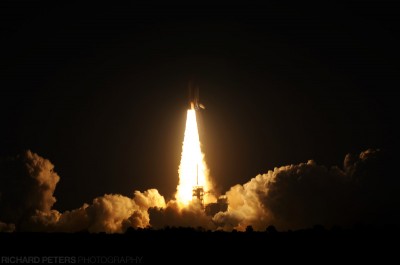
D300, 200-400 + 1.4x, 1/640, f5.6, ISO 200
Right time but where is the right place?
Having been originally planned to go up early February (the week AFTER I returned home from my previous trip), I was really pleased to find out the delays worked to my advantage with launch day just two days after my arrival in March. We didn’t even know it was due for that weekend until the night before when we happened to catch the news. So, the following morning we checked the weather and listened to the news to see if it was still going ahead which it was said to be. We weren’t sure if there would be heavy traffic and thousands of people everywhere so we got there 6 hours early, drove along the coastline a little to find a good vantage point then headed over the bridge towards Cape Canaveral to see if there were any good views there…it turned out there were none that we could get to so we had some lunch then headed back to the coastline along Titusville. It was 4 hours to launch and already the makeshift car parks were mostly full. Thankfully we stopped to ask one guy at the entrance to a closed parking area where else we could go and he kindly let us in to the area he was in control of. So, we parked up right near the water and walked along to the water front. There were people everywhere with no ‘front row’ views for me to set the tripod up but then I spotted a little outcrop of rocks with nobody on yet. So, I set my tripod up and then retreated to a little beach area just behind the rocks, where we sat and soaked in the sun for 4 hours whilst we waited for the events to unfold.
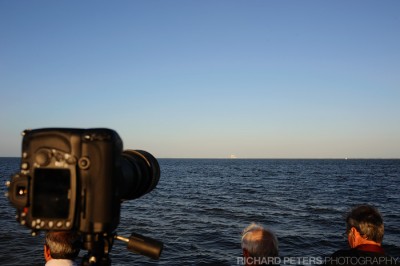
My vantage point, roughly 9 miles from launch pad 39A
Google maps tells me we were roughly 9 miles from the site. We could just see Launch Pad 39A off in the distance with the naked eye (and I do mean just), however with the D300, 200-400 and my 1.4x I was surprised at how visible things were…I mean of course it was still a way off but it offered a far superior view to the naked eye! The shot below is about %60-70 of the original frame.
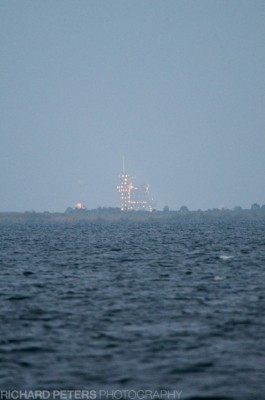
Launch Pad 39 A, 1/25, f5.6, ISO 1600
By the time things were about to kick off the crowds had built right up all along the coast and any spare bit of land that wasn’t occupied by buildings were occupied by people, so I was glad to have set up camp early to get a clear view across the water. It was a beautiful evening with the sun setting behind us and whilst we sat waiting I even managed to get a couple of shots of a passing manatee and a pelican bathed in low evening sun as it glided across the water.
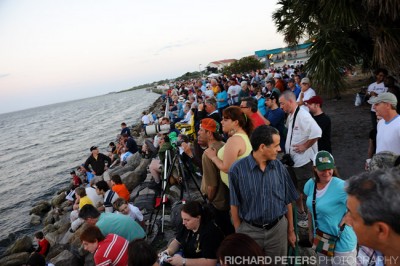
Crowds gathering
What settings? What camera?!
I have to admit…I was totally unsure how to prepare myself for what was to come. I mean I’ve never experienced anything like it before so had no idea what to expect! The launch was set for 15-20 minutes after sunset and the Pad was directly opposite where the sun had gone down, where the sky was at it’s darkest…do I shoot with the high ISO king, the D3…or do I go for the D300 and risk the noise for DX crop?! Right up till launch I was second guessing myself, especially when I was getting shutter speeds of 1/25 second at 1600 ISO with a focal length of 550mm just minutes before the countdown. I finally decided on the D300 for my long lens use and the D3 round my neck with the 28-70 attached.
The countdown begins
The whole time we were sat waiting, there was a guy next to us that had a radio tuned in to Nasa Mission Control so we could hear what was happening. When I heard the countdown begin I made one last check of my settings then looked up at the count of two to see the brilliant light of the boosters as they fired up. I quickly pressed my eye to the viewfinder and began shooting as I could see the shuttle lift off. Being so far away I had expected the smoke clouds to fit in the frame quite easily and so I was shooting in portrait mode to give the shuttle space to fly in to. However, I quickly realised the clouds kicked up where far wider than I had expected and so after taking 10 or so shots in portrait I switched to landscape and fired off a couple more frames. I then quickly switched to the D3 to capture the trail as it soared in to the sky then back to the D300, but by this point the shuttle was already moving pretty quickly in the viewfinder and within seconds it was getting to high to follow easily on the tripod, so I took it off and switched to hand held shooting as the shuttle climbed higher and higher in to the sky.
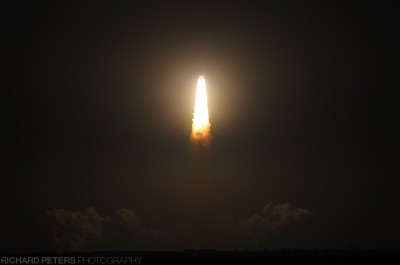
Discovery races in to the sky
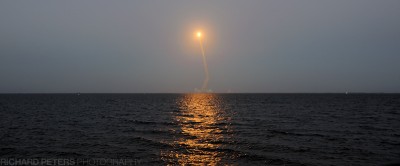
Light reflecting off the ocean
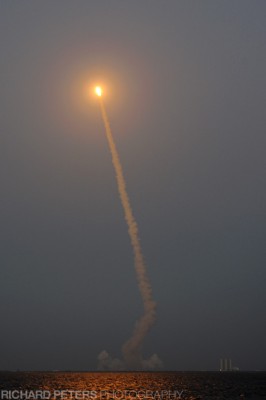
Space Shuttle Discovery
At this point I settled in to only shooting with the D3 and 28-70 as the shuttle was so far away now that it was just a spec of light, like a star in the sky. Once the shuttle was high enough up it burst in to sunlight casting golden hues on to the smoke trail it was leaving behind. This not only added some beautiful colour to the scene but it also had the advantage of casting a ‘beam of shadow’ through the air making an already incredible experience to witness even more stunning!
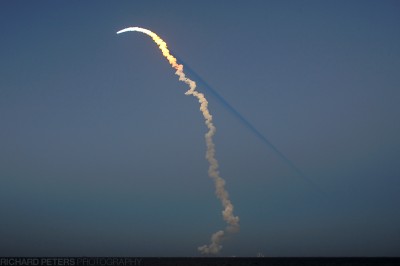
Discovery cuts through the last rays of sunlight
Just a few short minutes after launch the solid rocket boosters detach, although by this point the Shuttle is so high up that both it and the two rockets are nothing but small star like lights in the frame, as per the photo below.
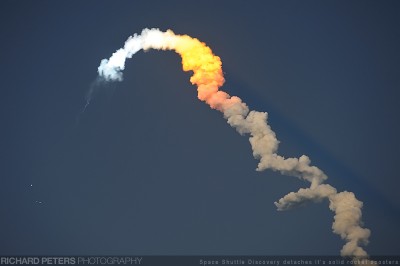
Solid Rocket Boosters detach
Once the boosters detached it didn’t take long for the small spec in the sky to completely vanish from vision and from that point on all we could do was watch the trails of smoke in the sky slowly dissipate as the crowed clapped and cheered before making their way back to the cars. It was quite dark by now but I grabbed a quick snap of the clouds as they slowly drifted apart.
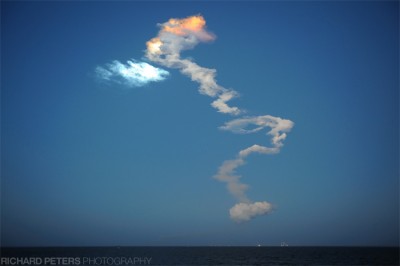
After the event
The whole thing was over in a matter of minutes and because I spent most of it looking through a camera I almost feel like I missed the event. Exposing for something like this was always going to be hit and miss with such low ambient light and looking back at the shots on the computer I wasn’t as pleased with some as I had thought I might be. But, the experience was incredible and something I am glad to have been witness to! I think the thing that amazed me most about it was just how bright and fast the lift off was (less than 15 minutes after launch the shuttle would be doing 14,500mph!!)! I was using auto ISO with the lens wide open and my camera settings went from 1/25, f5.6 at ISO 1600 just before launch to 1/640, f5.6 at ISO 200 as the rockets fired! Incredible, especially as this was on an object that was 9 miles away. With hindsight I would have done a couple of things differently but at the end of the day just seeing the launch gave me a buzz and to get any shots of it at all was just a bonus!








